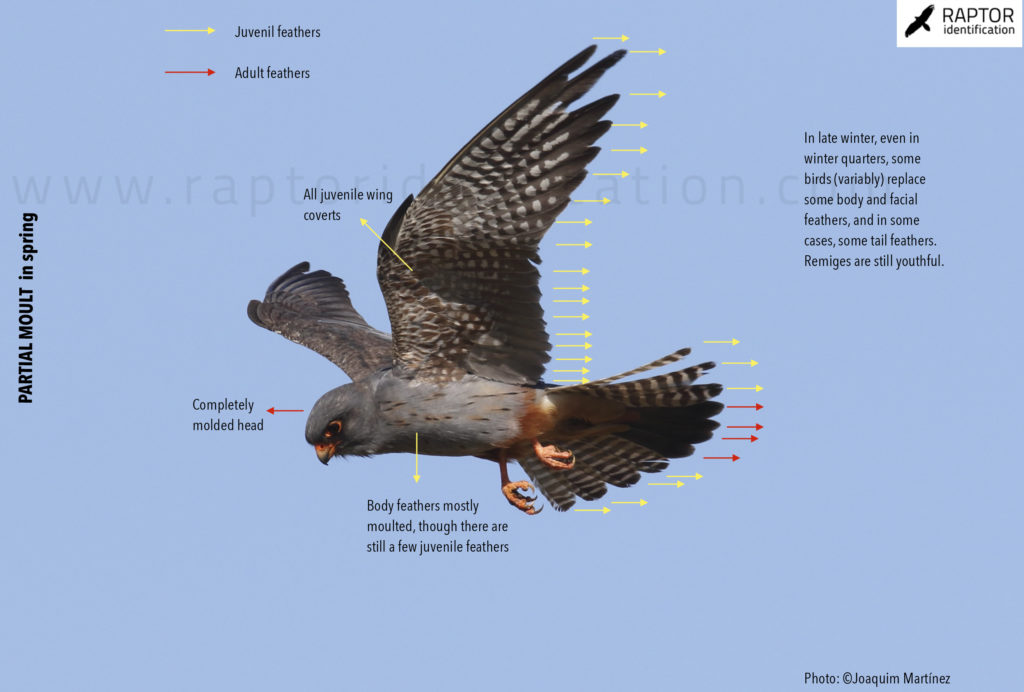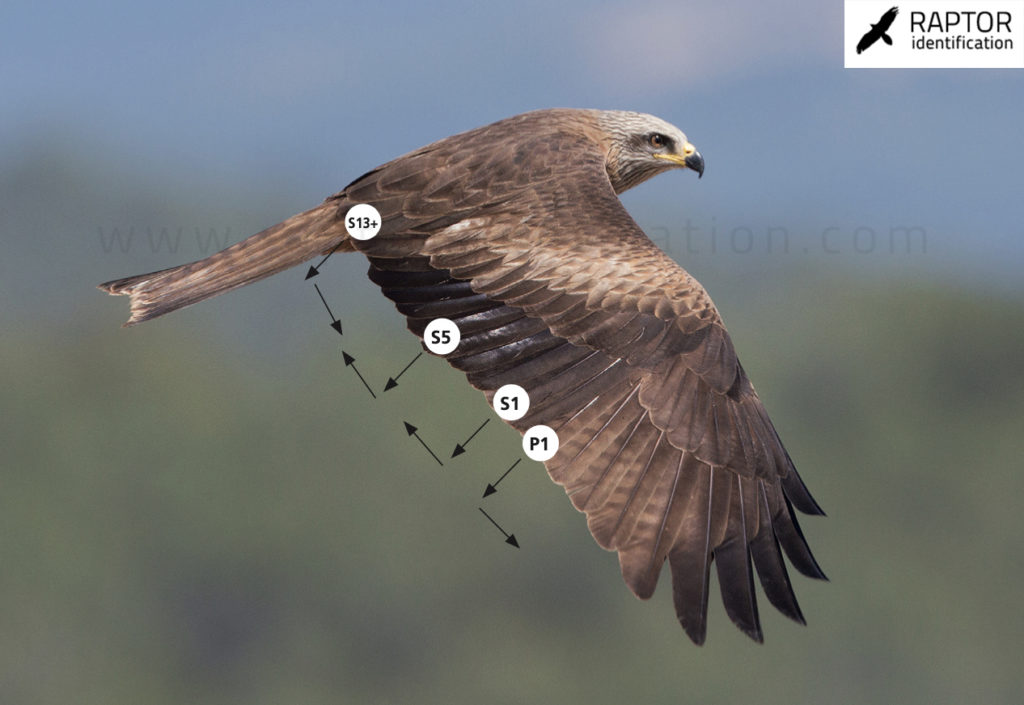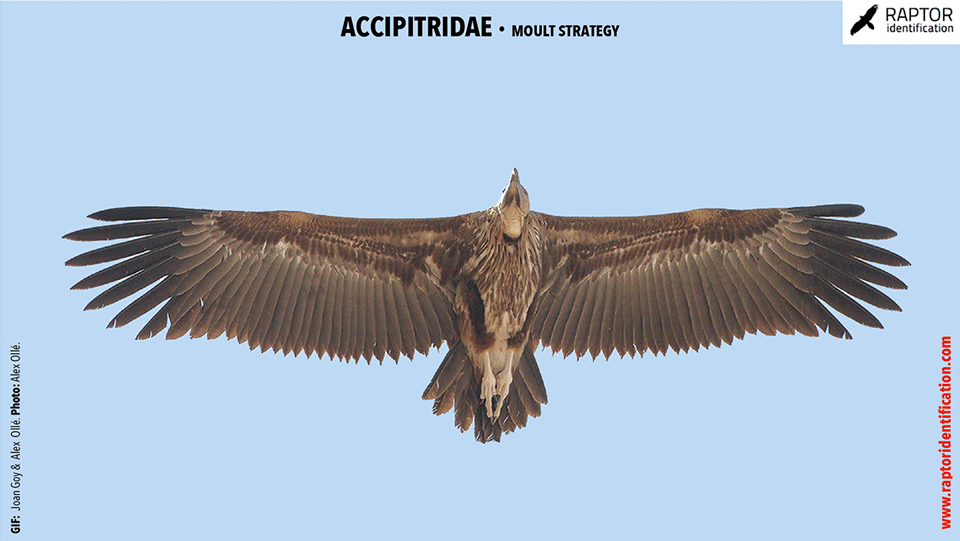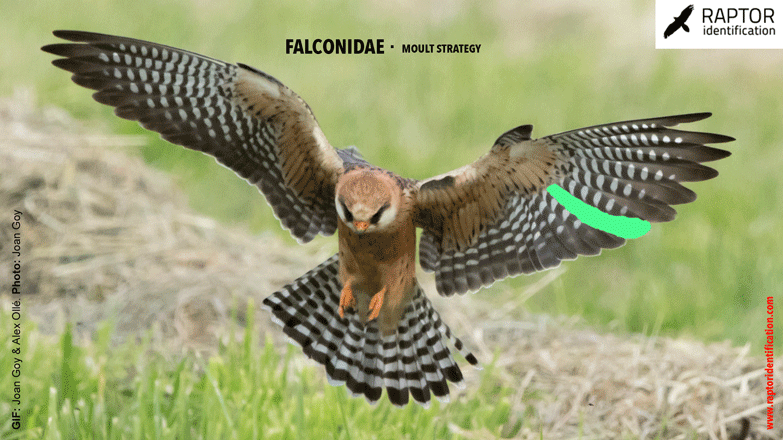
Introduction to Identification
Why raptors moult ? Bird feathers are made of keratin and once fully grown, they are a “dead” structure that cannot heal when gets damage. Feathers are under constant wear and birds groom them regularly, several times a day, to keep them in best condition. While preening, birds remove dust and parasites from their plumage, waterproff the feathers and keep them correctly aligninged for best insulation and aerodynamic flight. However, preening alone cannot keep feathers in optimum conditions for long and they will need to be replaced annually. The replacement of some or all old and worn feathers for new ones is called “moult”.
How do raptors moult ? The raptors of the western Palearctic have different moulting strategies which can be categorized into two.
The first one, followed by the majority of raptors as includes Accipitridae (all raptors except falcons) and Pandionidae (osprey), starts by replacing the most inner primary (p1) and continues neatly towards the outer part of the wing so that the most outer primary (p10) is the last feather to be replaced.
Shortly after replacing a few inner primaries, the moult of the secondaries starts but this time, from three different moult centers:
1) The most outer secondary (s1)
2) A middle secondary (s5)
3) The most inner one (numbering depending on the species’s size). From s1, the moult proceeds towards s5. From s5, the moult proceeds towards the most inner secondary. The last secondaries to moult are s4, s8 and s9.
The second strategy is the one followed by Falconidae. Falcons initiate the moult at primary p4 (sometimes p5) and replace the feathers neatly towards both ends: one towards p1 and the other towards p10 which will be the last primary to be replaced. Once some primaries are replaced, the moult of the secondaries starts but this time at the most inner secondary (numbering depending on the size of the species) and s5. From s5 the moult proceeds towards both ends: one towards the most inner secondary (meeting with the moult coming from this direction), and the other one towards s1 which will be the last secondary to be replaced.
The moult of the tail feathers is somehow independent, although birds usually moult the tail once they have started with the flight feathers. The moult of the tail feathers starts at the center of the tail (r1) and is usually followed by another moult center at both ends (r6). The feathers are neatly replaced from the center towards the ends and vice versa but it varies a lot between species.
When do raptors moult ? Raptors start moulting during their second calendar year, when they are approximately one year old. Moulting is a continuous process and moulting flight feathers has a hight energy cost. This cost is not compatible with other also high energy cost processess occurring during the birds’ annual cycle like breeding, migrating or wintering. Even wintering down in our latitudes has a high thermoregulation cost and that requires to suspend the moult. Generally speaking, both resident birds and transaharian migrants breeding on the Paleartic, initiate the moult in spring (as earliest as March and as latest as June/July) and suspend it in autumn (sometime between September-December). In this way, transaharians do not moult during migration and residents, do not moult during the coldest months, when thermoregulation is required.
Not all species follow the same temporal moulting patterns, though. Even different populations of the same species can moult following different timings. But, there are some excepcions. There is a moulting strategy called “seasonal moult” followed by part of the migrant raptors, where the moult occurs during two different periods. One in Europe. The other in Africa. It is the strategy followed by the honey buzzard, for example. The honey buzzard is a transaharian migrant that starts moulting at the end of June, or already in July. It replaces a maximum of four inner primaries before the autumn migration. When migration takes place, the moult is suspended. Once at the wintering grounds in Central Africa, the moult proceeds and the rest of the flight feathers are replaced. By the time that needs to leave on spring migration (April/May) the moult is finished.
Do raptors moult the whole plumage in one go, or through different years ? Recall the moult is a continuous process kept on hold at specific times of the year. Small and medium size raptors (from falcons to harriers) are capable of replacing all flight feathers within the same year, starting in spring and finishing in autumn. However, transaharian migrants like the Montagu’s harrier, undertake the so called “seasonal moult” coming back to Europe in spring with a full new set of feathers. On the other hand, the rest of medium sized and all bigger raptors (from buzzards to eagles and vultures) do not follow this rule as they need longer time to replace all their feathers. These raptors conduct a moult in different stages or “waves” (taking place in different consecutive years).
Do raptors moult in the same way regardless age, sex and latitude ? Non-breeding individuals have the opportunity to start moulting before than the breeding ones as they do not have the derived extra cost that egg production or incubation (in the case of females) or need of extra food supply (in the case of males) suppose. Accordingly, a 2nd calendar year short-toed eagle for example, coming back to Europe in spring (many of them remain in the Africa wintering grounds at this age) can moult the primary feathers already in March-April (actually, it can even reach Europe with some of the primaries already replaced), while adults do not moult until April or May.
On the other hand, some adults do not breed every year and others, fail on their breeding attempt and in such cases, those birds can also start moulting before. Amongst the breeding birds, females are the first ones to moult. In general, females lose their first primary feather at the end of the incubation time or when the chicks hatch. Two or three weeks after the chicks have hatched, the female join the male on the hunting task and as a result, males can start moulting as the energy they had to invest on hunting is now shared. This is why amongst the thousands and thousands of for example honey buzzards that cross the peninsula every September, we can see females showing up to four brand new primary feathers while males, only two.
For species with vast distribution ranges like the peregrine falcon, birds living in center and especially southern Europe are mostly resident birds, and only juveniles show some dispersion movements. These birds conduct a complete moult starting with females ssp.brookei in May, and finishing with males in October, when they replace the p10, as incubation will soon take place (e.g. already at the end of February in the Iberian Peninsula). However, the northernmost peregrine falcons ssp.calidus are migratory birds, breed mainly in June and therefore females do not moult until July-August. In September, moult is suspended so the energy can be invested to migrate. Once at the wintering grounds, moult will carry on until February, or even April for those birds wintering in southernmost Africa; opposite to non-breeders (2nd or 3rd calendar year birds) who can finish their moult in December-January (previous to adult breeding individuals). The same applies to sparrowhawks. In winter, in the Iberian Peninsula, we can see some sparrowhawks with all flight feathers replaces and some others (northern populations) that still retain some secondaries as they had to suspend the moult during the migration and eventually, they never ended by replacing them.
Complete and partial moult Complete moult refers to the phenomena of replacing all the bird’s feathers (i.e. facial, body and flight feathers: remiges = wing feathers; and rectrices = tail feathers). Contrary, partial moult is the phenomena of replacing only flight feathers and some of the facial and body feathers, as falcons (e.g. red-footed falcon), buzzards and harriers (Montagu’s harriers) can do.
Partial moult occurs in winter and it is especially obvious on juvenile birds, because of the difference in design and color between juvenile and replaced “adult type” feathers. The number of feathers that are replaced is highly variable, not only amongst species but also amongst individuals of the same species. Replaced feathers are mainly facial, “wing coverts”, scapulars, mantle, uppertail coverts and also sometimes, the pair of central rectrices.

Quality of the plumages The first plumage of a bird is called “juvenile plumage”. It is the plumage the bird gets at the nest and is developed in record time, with all feathers growing at once. This is the main difference between the juvenile plumage and all the other plumages, which grow stepwise and require a longer time. Not surprisingly, the juvenile plumage is not of a very good quality and worn out very fast. So, if we observe the tips of the feathers of a 2nd calendar year bird in spring or summer, we will easily notice their poor condition – they will be scruffy, shabby and worn, probably with some broken feather, especially primaries and rectrices. Juvenile feathers acquire a brownish color and a translucid aspect the older they become (very obvious when we can compare them with some new replaced feathers). Also, the plumage of juvenile birds wintering in warmer and arid areas will get more worn out by spring time, than the plumage of those juvenile birds wintering in benigner climates. The shape and size of the feathers is also different between juvenile and other plumages. In the juvenile plumage, the secondaries are narrower, pointier and do not have the dark and wide borders characteristic of adult feathers.

How to age a raptor We can only determine the exact age of a raptor if the bird retains a juvenile feather (especially remiges).
Once the species is ID we need to:
1) Look at how many juvenile feathers are retained and which ones they are
2) Consider the time of the year we are in
3) Know the moult strategy of the species
Only then we will be able to age the bird correctly. For example, a falcon with full juvenile plumage in March (perhaps with some replaced body feathers) is a 2nd calendar year bird. In September, this bird will only retain some juvenile outer primaries and a few secondaries, but the tail will be fully replaced. Next spring, this same bird will be in its 3rd calendar year. It may still retain some juvenile secondaries, which will be the clue that is in fact a 3rd calendar year bird. But in summer, once the moult is completed, the only thing we will be able to say is that this bird, is an adult and the exact age will not be possible to pinpoint anymore.
How to refer to the age of a raptor Literature is confusing when referring to transition plumages (i.e. plumages between concrete and specific ages). From an academic point of view, transition plumages are referred to as moult cycles. For example, a golden eagle has up to five moult cycles while a peregrine falcon has only two. Currently, people use terms like immature or sub-adult to refer to all those plumages between a juvenile and an adult bird. However, this is a very poor way to age these kind of birds. Remember that as far as the bird retain some juvenile feathers, we only need to ID the species correctly to determine its exact age (according to the moulting strategy and the number of retained juvenile feathers). We then refer to the raptors’ age as “calendar year”. This is what we have done here. For each photo, we have written down the calendar year of the bird and the month that the photo has been taken. Therefore, the use of the “calendar year” terminology allows to refer to the age of the raptors in a somehow standardized way.
Moreover, in cases such as the big eagles and vultures, where individuals of the same calendar year usually differ from each other due to their big size (for example, the extension of the moult may vary between birds of the same calendar year) this terminology facilitates the categorization of moulting characteristics into specific calendar years. Immature or sub-adult birds do not only differ from the adult birds in the color, shape and design of their plumages. The moult of the primary coverts retain a very characteristic symmetry between the two wings. Also other characteristics like color of the iris, may also differ between them. Once the bird reaches its adult plumage is when it will start to breed (although some may try before, often unsuccessfully). The adult plumage will keep its color, shape and design no matter how many times the bird will moult. Some old birds though may present small nuances in relation to “younger” adult plumages, like being brighter or less stripy. Adult birds are able to replace more flight feathers in less time however big raptors, require at least two years to achieve a complete moult. Consequently, there will be different moult centers on the wing and new and old feathers will be irregularly mixed up across the wing. The symmetry between the two wings concerning the moult of the primary coverts is not there anymore, especially in older birds who can “choose” which feathers to replace, because a certain feather has been damaged; or because some feathers are more valuable and frequently used than others.
Strategy of Accipitridae
Starts by replacing the most inner primary (p1) and continues neatly towards the outer part of the wing so that the most outer primary (p10) is the last feather to be replaced. Shortly after replacing a few inner primaries, the moult of the secondaries starts but this time, from three different moult centers:
1) The most outer secondary (s1)
2) A middle secondary (s5)
3) The most inner one (numbering depending on the species’s size). From s1, the moult proceeds towards s5. From s5, the moult proceeds towards the most inner secondary. The last secondaries to moult are s4, s8 and s9.

Large accipitriformes have more centres of moult on the secondaries than the ones described:
Strategy of Falconidae
Falcons initiate the moult at primary p4 (sometimes p5) and replace the feathers neatly towards both ends: one towards p1 and the other towards p10 which will be the last primary to be replaced. Once some primaries are replaced, the moult of the secondaries starts but this time at the most inner secondary (numbering depending on the size of the species) and s5. From s5 the moult proceeds towards both ends: one towards the most inner secondary (meeting with the moult coming from this direction), and the other one towards s1 which will be the last secondary to be replaced.






